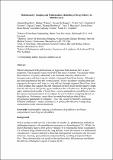Files in this item
Multimodality imaging and mathematical modelling of drug delivery to glioblastomas
Item metadata
| dc.contributor.author | Boujelben, Ahmed | |
| dc.contributor.author | Watson, Michael | |
| dc.contributor.author | McDougall, Steven | |
| dc.contributor.author | Yen, Yi-Fen | |
| dc.contributor.author | Gerstner, Elizabeth | |
| dc.contributor.author | Catana, Ciprian | |
| dc.contributor.author | Deisboeck, Thomas | |
| dc.contributor.author | Batchelor, Tracy | |
| dc.contributor.author | Boas, David | |
| dc.contributor.author | Rosen, Bruce | |
| dc.contributor.author | Kalpathy-Cramer, Jayashree | |
| dc.contributor.author | Chaplain, Mark Andrew Joseph | |
| dc.date.accessioned | 2017-08-19T23:32:24Z | |
| dc.date.available | 2017-08-19T23:32:24Z | |
| dc.date.issued | 2016-10-06 | |
| dc.identifier | 244397885 | |
| dc.identifier | 49b008ef-e16d-4cf7-a583-eff59cb85b81 | |
| dc.identifier | 84983449497 | |
| dc.identifier | 000382192900007 | |
| dc.identifier.citation | Boujelben , A , Watson , M , McDougall , S , Yen , Y-F , Gerstner , E , Catana , C , Deisboeck , T , Batchelor , T , Boas , D , Rosen , B , Kalpathy-Cramer , J & Chaplain , M A J 2016 , ' Multimodality imaging and mathematical modelling of drug delivery to glioblastomas ' , Interface Focus , vol. 6 , no. 5 , 20160039 . https://doi.org/10.1098/rsfs.2016.0039 | en |
| dc.identifier.issn | 2042-8898 | |
| dc.identifier.other | ORCID: /0000-0001-5727-2160/work/55378931 | |
| dc.identifier.uri | https://hdl.handle.net/10023/11513 | |
| dc.description | MAJC would like to thank the Isaac Newton Institute for Mathematical Sciences for its hospitality during the programme “Coupling Geometric PDEs with Physics for Cell Morphology, Motility and Pattern Formation” supported by EPSRC Grant Number EP/K032208/1. | en |
| dc.description.abstract | Patients diagnosed with glioblastoma, an aggressive brain tumour, have a poor prognosis, with a median overall survival of less than 15 months. Vasculature within these tumours is typically abnormal, with increased tortuosity, dilation and disorganization and they typically exhibit a disrupted blood brain barrier. Although it has been hypothesized that the “normalization” of the vasculature resulting from anti-angiogenic therapies could improve drug delivery through improved blood flow, there is also evidence that suggests that the restoration of blood brain barrier integrity might limit the delivery of therapeutic agents and hence their effectiveness. In this paper we apply mathematical models of blood flow, vascular permeability and diffusion within the tumour microenvironment to investigate the effect of these competing factors on drug delivery. Preliminary results from the modelling indicate that all three physiological parameters investigated – flow rate, vessel permeability, and tissue diffusion coefficient – interact nonlinearly to produce the observed average drug concentration in the microenvironment. | |
| dc.format.extent | 9 | |
| dc.format.extent | 8152014 | |
| dc.language.iso | eng | |
| dc.relation.ispartof | Interface Focus | en |
| dc.subject | Multimodality imaging | en |
| dc.subject | Glioblastoma | en |
| dc.subject | Drug delivery | en |
| dc.subject | Perfusion | en |
| dc.subject | Computational modelling and simulation | en |
| dc.subject | RM Therapeutics. Pharmacology | en |
| dc.subject | QA Mathematics | en |
| dc.subject | QH301 Biology | en |
| dc.subject | NDAS | en |
| dc.subject.lcc | RM | en |
| dc.subject.lcc | QA | en |
| dc.subject.lcc | QH301 | en |
| dc.title | Multimodality imaging and mathematical modelling of drug delivery to glioblastomas | en |
| dc.type | Journal article | en |
| dc.contributor.institution | University of St Andrews. Applied Mathematics | en |
| dc.identifier.doi | https://doi.org/10.1098/rsfs.2016.0039 | |
| dc.description.status | Peer reviewed | en |
| dc.date.embargoedUntil | 2017-08-19 |
This item appears in the following Collection(s)
Items in the St Andrews Research Repository are protected by copyright, with all rights reserved, unless otherwise indicated.

